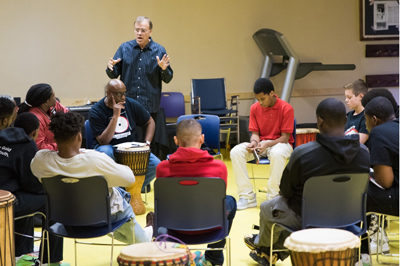by Daniel Hathaway

That opening gesture set the tone for a vivid journey through the 27 scenes of the score Stravinsky wrote for Serge Diaghilev’s Ballet Russe in 1910. Most often, audiences encounter the Firebird story through the suites Stravinsky extracted. Hearing the score from one end to the other allowed the E.J. Thomas crowd to follow the whole sequence of the narrative, including some wonderful music that connects the ballet’s more familiar scenes.
Supertitles kept us abreast of what was happening, and the Orchestra’s lively playing kept us on the edge of our seats by musical means alone.
Firebird is a big production whose orchestration includes three harps, triple winds, piano and celesta, and extensive percussion in addition to a full string section. Offstage and front-of-stage trumpets — and at one point four Wagner tubas who appeared stage right — added to the sonic splendor.
Wilkins paced the score adroitly, and splendid ensemble playing prevailed throughout the 45-minute work. But truly impressive soloists, some of whom represented characters in the story, lifted the performance to lofty heights. Hornist Megan Guegold, clarinetist Amitai Vardi and E-flat clarinetist Heidi Peck, oboist Terry Orcutt, and bassoonist Todd Jelen all covered themselves in Stravinskian glory.

Myths also inspired the first half of the concert. Carl Maria von Weber’s Freischütz Overture gave the Orchestra’s horns and brass several opportunities to shine in glorious chorales and fanfares. Amitai Vardi contributed another handsome solo, and the strings dispatched Weber’s busy writing with grace and confidence.
Ravel’s second suite from Daphnis and Chloé begins with a quiet riot of birds before a resplendent sunrise, and ends with a general dance of nymphs and shepherds. The flutes set up a luminous scene, but transitions between the three sections of the suite needed a bit more attention, and the final rejoicing a bit more abandon. In that last section, Wilkins kept a tight rein on the Orchestra, precisely conducting every beat of Ravel’s 5/4 bars. A more sweeping approach would have helped bring Daphnis up to the thrilling levels of Firebird.
Photos: Alchemy, Inc.
Published on ClevelandClassical.com February 15, 2017.
Click here for a printable copy of this article



